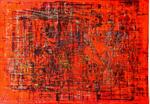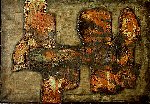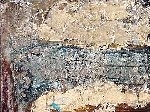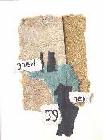The image on the right by
RUDOLF ENGERS
is made
with an ordinary paint-roller. It is a very simple way
not using a brush as most painters usually do.
ENGERS
worked in a very subtle way, just touching the paper
with a narrow
surface of the roller.
In that way he gained a lively "print". It is from 1959.
|

|
|
In our opinion it all started with the use of sand and ashes by
TAP�ES
:
a way to thicken the paint from a tube, so that it is possible to use it as a
kind of paste. At the same time that
influences the colour of the paint: darker, greyish, dryer. It is no wonder
that the colour black
was used often. In the painting at the right,
COR DE NOBEL,
1958, also used plaster of Paris besides sand, ashes and siccative.
|

|

|
TAJOKA
, who we met before, made this drawing in 1958. He made his own
ink and his own feather-pens. He had been, as a sailorman, in Japan and was a
real ZEN-adept knowing
several japanese poems by head. Even the strokes of the pen here are
"japanese" and recalls strongly the
characters in japanese writing.
|

|
Here another painting which shows (use the thumbnail!) clearly the use of "new"
materials: sand,
ashes and plaster of Paris, and a lot of siccative. People in that time used to
say that the painting would be
destroyed soon. That was in '58 and it is still in order. Later on you can see
the use of glass and iron.
COR DE NOBEL
, from 1958.
|
|
The collage here at the right seems a joke, because it is a greeting-card, but
HERMAN DE VRIES
used all sorts of material to give birth to his ideas. He was famous for using
(very old) napkins which he ducked in plaster so they stiffened. The
Museum Groningen
posesses a
large collection of his "leaves" as we call them (real leaves from real trees)
which he arranged with great
accuracy. The date of this collage is clear: 1959.
|

|
|
The last image on this page is made by the painter
JAN CREMER
. He became famous in the Netherlands
with his book "Ik Jan Cremer" from the time that he advertised himself as an
"angry young man" . Later on he made big paintings and tried
to sell them for f. 1.000.000.= which did not work out. He painted in an
expressionistic way: speedy in wide strokes and with pure colours (Sold to
gallery "de Rijk" in The Hague.)
|

|





